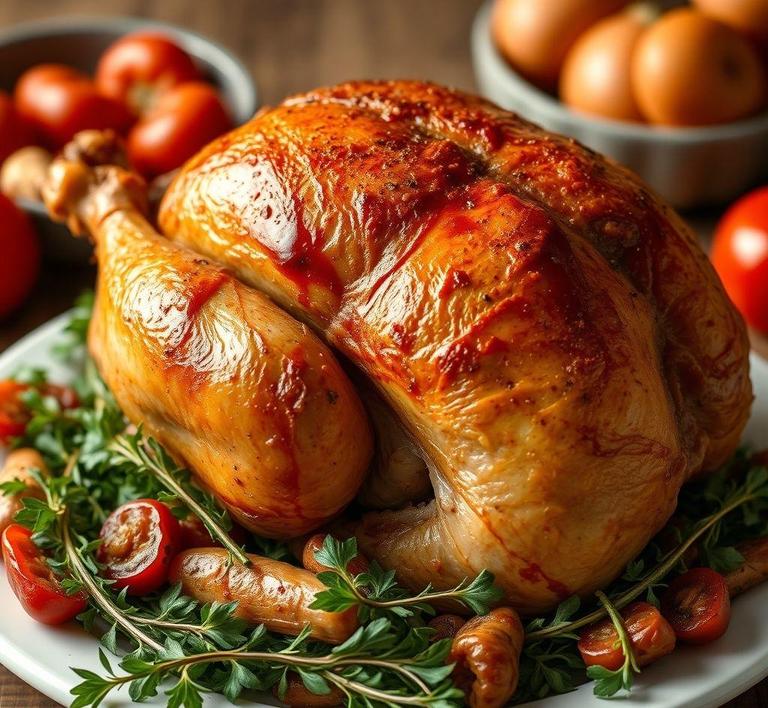After a big holiday feast, there’s usually plenty of turkey left over, and the thought of wasting it is a no-go for most of us. If you’re wondering whether you can refreeze that leftover turkey, you’re not alone! The good news is, you can refreeze turkey, but it’s important to do it right to maintain flavor and texture. Refreezing turkey can be a smart way to stretch leftovers and avoid unnecessary waste. However, it’s crucial to know when and how to freeze it to ensure safety and the best quality. This guide will walk you through all the steps to safely refreeze leftover turkey, so you can enjoy it later without any worries!
Can You Refreeze Leftover Turkey?

The short answer is: yes, but with important caveats. Whether you can safely refreeze leftover turkey depends largely on how it was handled after cooking and how long it has been out at room temperature.
Here’s why: after cooking, turkey (like all cooked poultry) enters the "danger zone" for bacterial growth-between 40°F (4°C) and 140°F (60°C). If the turkey sits out too long in this temperature range, harmful bacteria can multiply to unsafe levels, increasing the risk of foodborne illness. Refreezing in this scenario won’t kill bacteria; freezing only pauses their growth.
Key Factors That Allow Safe Refreezing
- Prompt refrigeration: The turkey must be cooled and placed in the fridge within 2 hours of cooking (or 1 hour if ambient temperature is above 90°F/32°C).
- Proper storage: Leftovers should be stored in airtight containers or wrapped tightly to avoid contamination and freezer burn.
- Minimal time thawed: If you thawed frozen cooked turkey in the refrigerator and it’s still cold (below 40°F), it’s generally safe to refreeze.
If these conditions are met, refreezing is safe. However, if turkey has been left out too long or thawed improperly (e.g., thawed on the counter), refreezing is not recommended.
How To Refreeze Leftover Turkey?
Refreezing turkey properly requires attention to detail to ensure both safety and quality:
- Cool leftovers quickly: After your meal, remove turkey from the hot serving platter and divide it into smaller portions. Place these portions into shallow containers or spread on baking sheets so they cool faster in the fridge. Ideally, turkey should be refrigerated within 2 hours of cooking.
- Use airtight packaging: When you’re ready to freeze, wrap the turkey tightly in heavy-duty aluminum foil, plastic wrap, or freezer paper. Alternatively, place it inside freezer bags with as much air squeezed out as possible. Vacuum sealing is ideal for preserving freshness and preventing freezer burn.
- Label and date: Always label your packages with the date you are freezing the turkey. This helps you keep track of storage times.
- Freeze promptly: Put the turkey in the freezer right away. Try to keep the freezer temperature steady at 0°F (-18°C) or lower.
- Safe thawing for reuse: When you’re ready to use the turkey again, thaw it in the refrigerator, not on the counter. This helps keep the turkey within safe temperatures and minimizes bacterial growth.
Quality Impact
While refreezing leftover turkey is generally safe under proper conditions, there is an inevitable impact on quality that’s worth understanding:
- Texture changes: Freezing causes ice crystals to form in the turkey’s muscle fibers, which can rupture the cells. When thawed, this often results in a slightly drier, more crumbly texture compared to freshly cooked turkey.
- Flavor degradation: Over time, even well-packaged turkey can lose some of its fresh flavor and develop freezer burn if exposed to air. Refreezing exacerbates this by introducing additional freeze-thaw cycles.
- Moisture loss: Each freeze-thaw cycle leads to moisture loss, which means reheated turkey may feel less juicy and more fibrous.
To minimize these effects, it’s best to refreeze turkey only once and consume it within 2-3 months. Using turkey in soups, casseroles, or pot pies after refreezing can also help mask any slight texture or flavor changes, making it enjoyable while reducing waste.
Refreezing leftover turkey is safe and feasible provided that food safety guidelines are followed meticulously. The key lies in quick refrigeration after cooking, proper packaging, and limiting the number of thaw-freeze cycles to protect both safety and quality. While refreezing does affect the texture and moisture of the turkey somewhat, thoughtful storage and creative reheating can preserve much of its deliciousness.
In essence, refreezing leftover turkey offers a practical way to extend the life of your holiday feast, minimize food waste, and enjoy turkey beyond just one meal-so long as safety and quality precautions are respected.
Is It Safe To Refreeze Leftover Turkey?
Refreezing leftover turkey is a question that often arises after holiday feasts or large gatherings. The short answer is: it depends. Food safety experts generally caution against refreezing meat that has been fully thawed and left at room temperature for extended periods, as harmful bacteria can multiply rapidly in the "danger zone" between 40°F and 140°F (4°C and 60°C). However, if your turkey was handled properly-thawed safely in the refrigerator, cooked thoroughly, cooled promptly, and refrigerated within two hours-then refreezing is typically safe.
When turkey is cooked and immediately stored in the fridge, the cold environment slows bacterial growth significantly. If you refreeze turkey that has only been thawed in the fridge and hasn’t been left out for too long, you won’t necessarily compromise safety. However, the texture and quality of the meat may degrade somewhat due to moisture loss during freezing and thawing cycles.
In essence, safety hinges on how the turkey was handled before freezing and how long it’s been out. Proper refrigeration and prompt freezing are key to minimizing foodborne illness risks.
Signs That Leftover Turkey Should Not Be Refrozen
Knowing when not to refreeze leftover turkey is just as critical as knowing when you can. Here are some telltale signs that your turkey should not go back into the freezer:
- Unpleasant Odor: If the turkey emits a sour, rancid, or off-putting smell, bacteria may have begun to proliferate. This is a strong indicator that the turkey has spoiled.
- Slimy or Sticky Texture: A slimy surface on the meat is a sign of bacterial growth and degradation of the turkey’s proteins, signaling that the meat has gone bad.
- Left Out Too Long: If turkey has been sitting at room temperature for more than 2 hours (or 1 hour if above 90°F/32°C), bacteria can multiply rapidly. Refreezing will not kill bacteria-it only halts their growth temporarily.
- Discoloration: If you notice greyish or greenish hues on the meat, it’s a warning sign that spoilage has set in.
- Improper Storage: If the turkey was thawed in water or the microwave and then left to cool too long before refrigeration, this can increase spoilage risk. Such meat should not be refrozen.
Common Refreezing Mistakes
Even if you understand the basics, many people make avoidable mistakes when refreezing turkey, which can impact both safety and quality:
- Refreezing After Room Temperature Thawing: Thawing turkey on the countertop or in warm water can bring the meat into the danger zone for too long. Refreezing it afterward won’t undo bacterial growth.
- Not Cooling Properly Before Freezing: Freezing hot or warm turkey traps heat inside the freezer and can raise the overall temperature, partially thawing other foods. Always cool leftovers in shallow containers to refrigerate quickly before freezing.
- Multiple Freeze-Thaw Cycles: Each time turkey is thawed and refrozen, the texture deteriorates due to ice crystal formation rupturing meat fibers. This can result in dry, tough turkey.
- Freezing in Large, Thick Portions: Large chunks freeze unevenly and thaw slower, increasing the risk of bacteria multiplying before the center is cold enough.
- Using Non-Airtight Packaging: Poor wrapping causes freezer burn, which dries out the turkey and ruins flavor and texture.
Tips And Tricks
To get the best results when refreezing leftover turkey, follow these pro tips:
- Freeze in Small Portions: Slice or shred turkey before freezing. This helps with quicker thawing and reduces the temptation to refreeze large portions repeatedly.
- Use Airtight Containers or Vacuum Seal: Prevent freezer burn by sealing turkey tightly with plastic wrap, freezer bags, or vacuum sealers.
- Label and Date Everything: Keep track of how long your turkey has been frozen. Ideally, use frozen turkey within 3-4 months for optimal taste and texture.
- Cool Quickly: Divide leftovers into shallow containers to refrigerate immediately after the meal, then freeze within 2-3 days.
- Thaw Safely: Always thaw turkey in the refrigerator or using the defrost setting on your microwave. Avoid thawing at room temperature.
- Reheat Thoroughly: When reheating refrozen turkey, ensure it reaches an internal temperature of 165°F (74°C) to kill any bacteria.
Conclusion
Refreezing leftover turkey can be perfectly safe if handled correctly. The key lies in careful storage, timely refrigeration, and understanding the signs of spoilage. While refreezing might slightly affect the texture, it’s a practical way to minimize food waste and savor your holiday feast over multiple meals. Avoid common pitfalls like thawing on the counter or refreezing meat that has been left out too long. Armed with the right knowledge and simple food safety habits, you can enjoy your turkey leftovers with peace of mind and zero compromise on health.


